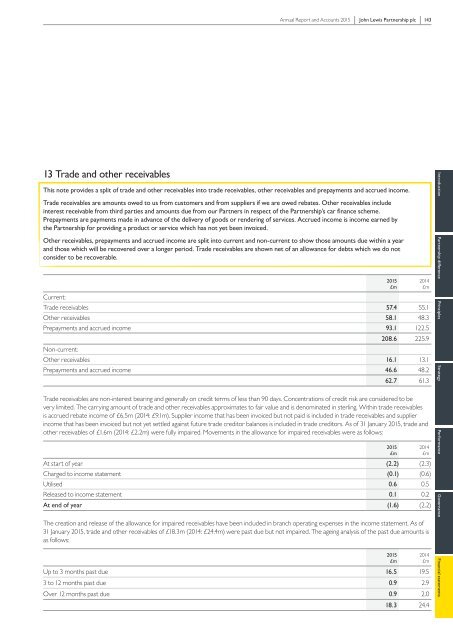john-lewis-partnership-plc-annual-report-2015
john-lewis-partnership-plc-annual-report-2015
john-lewis-partnership-plc-annual-report-2015
Create successful ePaper yourself
Turn your PDF publications into a flip-book with our unique Google optimized e-Paper software.
Annual Report and Accounts <strong>2015</strong> John Lewis Partnership <strong>plc</strong> 143<br />
13 Trade and other receivables<br />
This note provides a split of trade and other receivables into trade receivables, other receivables and prepayments and accrued income.<br />
Trade receivables are amounts owed to us from customers and from suppliers if we are owed rebates. Other receivables include<br />
interest receivable from third parties and amounts due from our Partners in respect of the Partnership’s car finance scheme.<br />
Prepayments are payments made in advance of the delivery of goods or rendering of services. Accrued income is income earned by<br />
the Partnership for providing a product or service which has not yet been invoiced.<br />
Other receivables, prepayments and accrued income are split into current and non-current to show those amounts due within a year<br />
and those which will be recovered over a longer period. Trade receivables are shown net of an allowance for debts which we do not<br />
consider to be recoverable.<br />
Current:<br />
Trade receivables 57.4 55.1<br />
Other receivables 58.1 48.3<br />
Prepayments and accrued income 93.1 122.5<br />
208.6 225.9<br />
Non-current:<br />
Other receivables 16.1 13.1<br />
Prepayments and accrued income 46.6 48.2<br />
62.7 61.3<br />
Trade receivables are non-interest bearing and generally on credit terms of less than 90 days. Concentrations of credit risk are considered to be<br />
very limited. The carrying amount of trade and other receivables approximates to fair value and is denominated in sterling. Within trade receivables<br />
is accrued rebate income of £6.5m (2014: £9.1m). Supplier income that has been invoiced but not paid is included in trade receivables and supplier<br />
income that has been invoiced but not yet settled against future trade creditor balances is included in trade creditors. As of 31 January <strong>2015</strong>, trade and<br />
other receivables of £1.6m (2014: £2.2m) were fully impaired. Movements in the allowance for impaired receivables were as follows:<br />
At start of year (2.2) (2.3)<br />
Charged to income statement (0.1) (0.6)<br />
Utilised 0.6 0.5<br />
Released to income statement 0.1 0.2<br />
At end of year (1.6) (2.2)<br />
The creation and release of the allowance for impaired receivables have been included in branch operating expenses in the income statement. As of<br />
31 January <strong>2015</strong>, trade and other receivables of £18.3m (2014: £24.4m) were past due but not impaired. The ageing analysis of the past due amounts is<br />
as follows:<br />
Up to 3 months past due 16.5 19.5<br />
3 to 12 months past due 0.9 2.9<br />
Over 12 months past due 0.9 2.0<br />
18.3 24.4<br />
<strong>2015</strong><br />
£m<br />
<strong>2015</strong><br />
£m<br />
<strong>2015</strong><br />
£m<br />
2014<br />
£m<br />
2014<br />
£m<br />
2014<br />
£m<br />
Introduction Partnership difference Principles Strategy Performance Governance Financial statements


